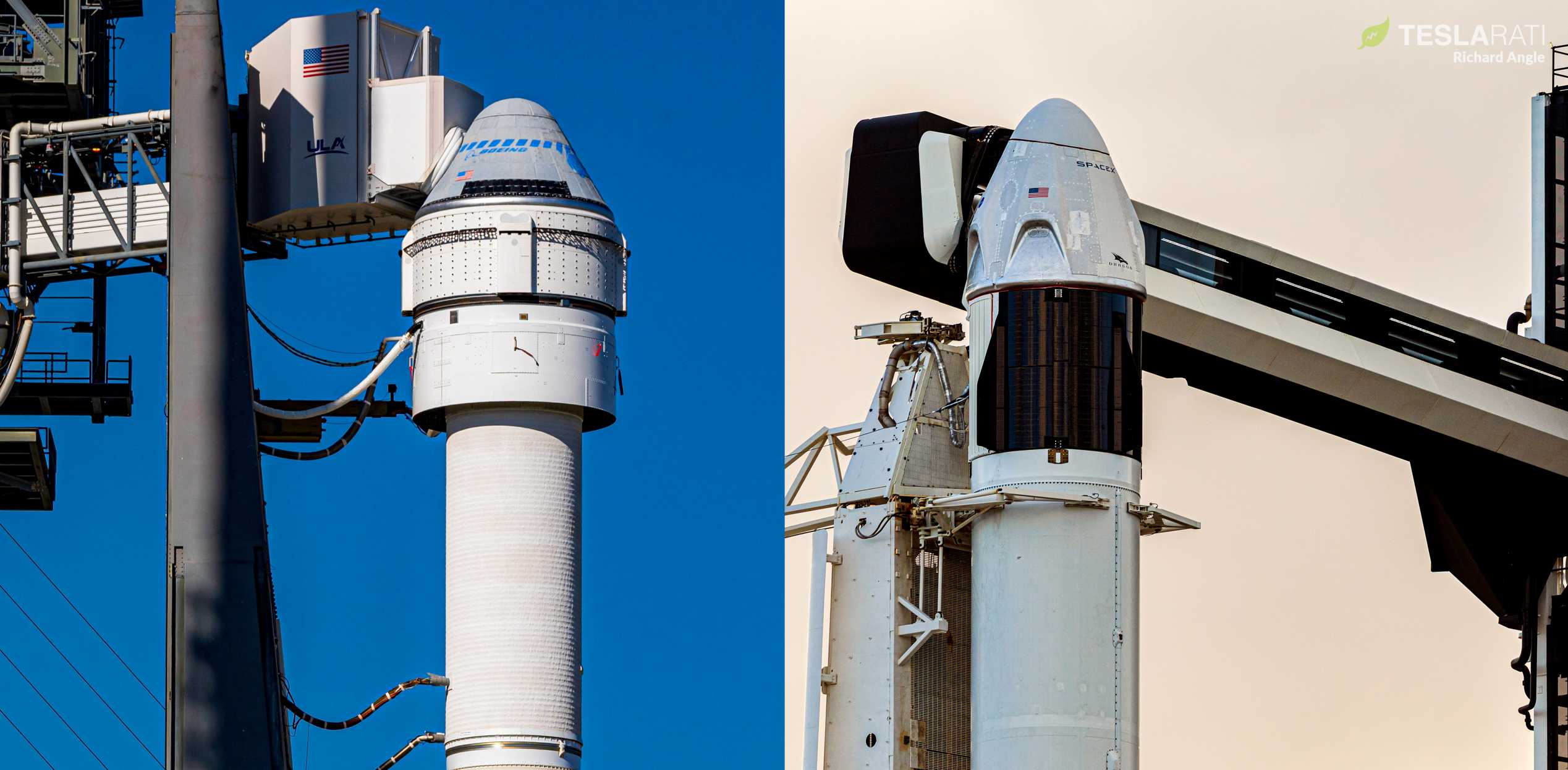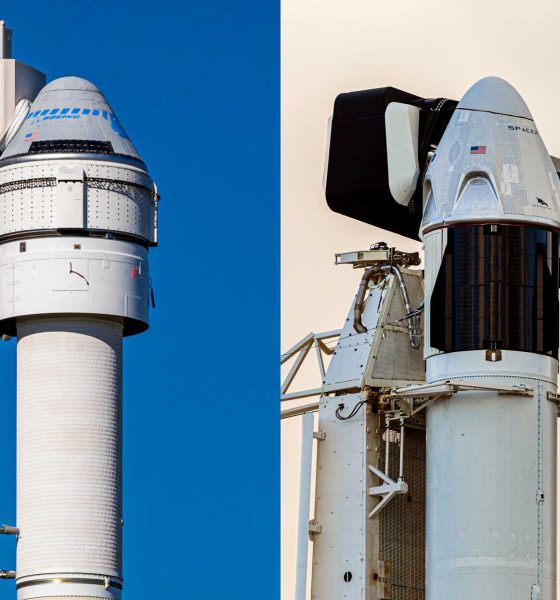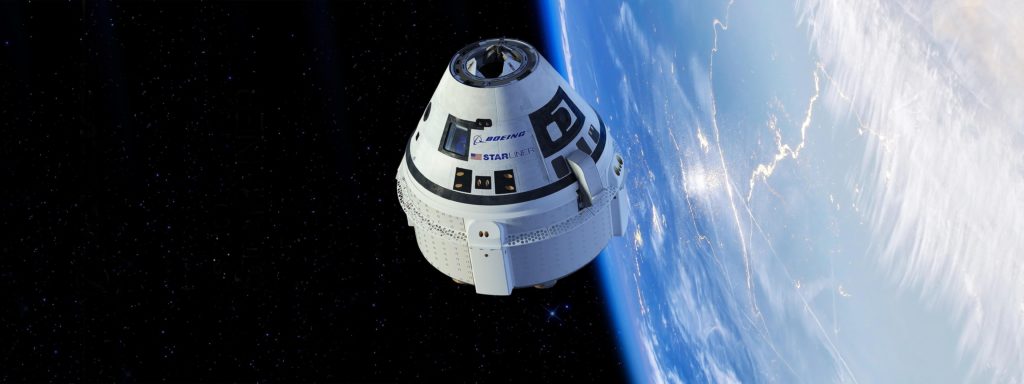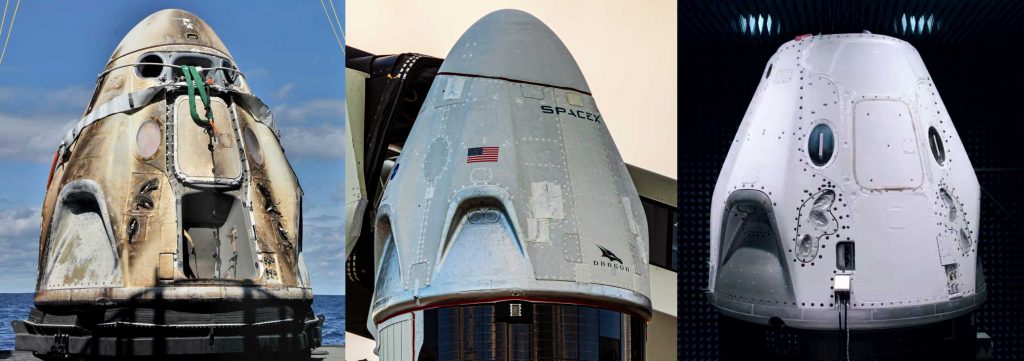

News
SpaceX, Boeing astronaut spacecraft working towards orbital meet-up in 2020
According to Boeing’s new Starliner testing plan, the spacecraft could potentially meet SpaceX’s own Crew Dragon astronaut spacecraft in orbit at the International Space Station (ISS) later this year.
Following Starliner’s near-catastrophic December 2019 orbital flight test (OFT), Boeing and NASA have finally announced that – at a minimum – a second uncrewed flight test will have to be completed before the company will be allowed to launch astronauts. According to the Washington Post, Starliner’s return to flight is expected to occur no earlier than October or November 2020, 10 or 11 months after it suffered several major software failures during its first spaceflight. While delays to that flight schedule are incredibly likely, it does mean that there’s a chance that SpaceX’s second crewed Crew Dragon launch could coincide with Starliner’s second orbital mission — a first for the two NASA Commercial Crew Program (CCP) providers.
Just one week before NASA and Boeing revealed plans to refly Starliner’s uncrewed flight test, NASA announced that SpaceX’s first operational Crew Dragon launch now has a full four astronauts assigned to it. Scheduled to launch no earlier than Q4 2020, the spacecraft will carry three NASA astronauts and one Japanese (JAXA) astronaut to the ISS, remaining in orbit for at least six months before returning its crew back to Earth. Now, there’s a chance that SpaceX’s first operational Crew Dragon will be joined in orbit by Boeing’s Starliner spacecraft sometime soon after arriving on station.


As previously discussed on Teslarati, Boeing’s Starliner OFT suffered several near-catastrophic close calls in the few days it spent in space, all of which appear to have egregiously shoddy and unqualified software to blame.
“Starliner launched atop a ULA Atlas V rocket on its orbital launch debut (OFT) on December 20th, 2019. Atlas V performed flawlessly but immediately after Starliner separated from the rocket, things went very wrong.
Bad software ultimately caused the spacecraft to perform thousands of uncommanded maneuvering thruster burns, depleting a majority of its propellant before Boeing was able to intervene. Starliner managed to place itself in low Earth orbit (LEO), but by then it had nowhere near enough propellant left to rendezvous and dock with the ISS – one of the most crucial purposes of the flight test. Unable to complete that part of the mission, Boeing instead did a few small tests over the course of 48 hours in orbit before commanding the spacecraft’s reentry and landing on December 22nd.
The Starliner spacecraft also reportedly almost suffered a second major software failure just hours before reentry. According to NASA and Boeing comments in a press conference held only after news of that second failure broke, a second Starliner software bug – caught only because the first failure forced Boeing to double-check its code – could have had far more catastrophic consequences. NASA stated that had the second bug not been caught, some of Starliner’s thruster valves would have been frozen, either entirely preventing or severely hampering the spacecraft’s detached trunk from properly maneuvering in orbit. Apparently, that service module (carrying fuel, abort engines, a solar array, and more) could have crashed into the crew module shortly after detaching.”
Teslarati.com — February 11th, 2020
The only sane response was obviously for NASA to require Boeing to successfully complete a second Orbital Flight Test (OFT), a necessary decision the space agency and card-holder was bizarrely hesitant to acknowledge. Now, almost four months after Starliner was nearly lost on its first orbital flight test, NASA and Boeing have finally stated the obvious and confirmed that a second OFT will be required before astronauts can fly on Starliner. Even then, if things go wrong during OFT2 or Boeing completes the mission but still fails to rectify all faults identified by a joint failure investigation, NASA may still delay the spacecraft’s astronaut launch debut.

SpaceX has undeniably had its own stumbles while developing Crew Dragon, most notably when the first successfully flight-proven spacecraft violently exploded moments before a static fire test in April 2019. SpaceX was able to rectify the responsible design flaws and successfully complete an identical static fire test less than seven months later, followed by a second successful launch less than three months after that. Based on WaPo’s indication that Starliner’s second OFT is scheduled for Q4 2020, Boeing is now anywhere from 12-18 months behind SpaceX with its efforts to launch NASA astronauts to and from the space station. SpaceX successfully completed Crew Dragon’s OFT equivalent in March 2019.
Regardless, if Crew Dragon performs flawlessly during its Demo-2 astronaut launch debut – scheduled no earlier than mid-to-late May – and Boeing’s Starliner OFT2 mission launches on time in Q4 2020, there is a great chance that both spacecraft will be simultaneously docked to the space station. Better circumstances would be unequivocally preferable but it will still mark an important symbolic milestone for NASA’s Commercial Crew Program (CCP) and assured access to the ISS.

News
Tesla dispels reports of ‘sales suspension’ in California
“This was a “consumer protection” order about the use of the term “Autopilot” in a case where not one single customer came forward to say there’s a problem.
Sales in California will continue uninterrupted.”

Tesla has dispelled reports that it is facing a thirty-day sales suspension in California after the state’s Department of Motor Vehicles (DMV) issued a penalty to the company after a judge ruled it “misled consumers about its driver-assistance technology.”
On Tuesday, Bloomberg reported that the California DMV was planning to adopt the penalty but decided to put it on ice for ninety days, giving Tesla an opportunity to “come into compliance.”
Tesla enters interesting situation with Full Self-Driving in California
Tesla responded to the report on Tuesday evening, after it came out, stating that this was a “consumer protection” order that was brought up over its use of the term “Autopilot.”
The company said “not one single customer came forward to say there’s a problem,” yet a judge and the DMV determined it was, so they want to apply the penalty if Tesla doesn’t oblige.
However, Tesla said that its sales operations in California “will continue uninterrupted.”
It confirmed this in an X post on Tuesday night:
This was a “consumer protection” order about the use of the term “Autopilot” in a case where not one single customer came forward to say there’s a problem.
Sales in California will continue uninterrupted.
— Tesla North America (@tesla_na) December 17, 2025
The report and the decision by the DMV and Judge involved sparked outrage from the Tesla community, who stated that it should do its best to get out of California.
One X post said California “didn’t deserve” what Tesla had done for it in terms of employment, engineering, and innovation.
Tesla has used Autopilot and Full Self-Driving for years, but it did add the term “(Supervised)” to the end of the FSD suite earlier this year, potentially aiming to protect itself from instances like this one.
This is the first primary dispute over the terminology of Full Self-Driving, but it has undergone some scrutiny at the federal level, as some government officials have claimed the suite has “deceptive” naming. Previous Transportation Secretary Pete Buttigieg was vocally critical of the use of the name “Full Self-Driving,” as well as “Autopilot.”
News
New EV tax credit rule could impact many EV buyers
We confirmed with a Tesla Sales Advisor that any current orders that have the $7,500 tax credit applied to them must be completed by December 31, meaning delivery must take place by that date. However, it is unclear at this point whether someone could still claim the credit when filing their tax returns for 2025 as long as the order reflects an order date before September 30.

Tesla owners could be impacted by a new EV tax credit rule, which seems to be a new hoop to jump through for those who benefited from the “extension,” which allowed orderers to take delivery after the loss of the $7,500 discount.
After the Trump Administration initiated the phase-out of the $7,500 EV tax credit, many were happy to see the rules had been changed slightly, as deliveries could occur after the September 30 cutoff as long as orders were placed before the end of that month.
However, there appears to be a new threshold that EV buyers will have to go through, and it will impact their ability to get the credit, at least at the Point of Sale, for now.
Delivery must be completed by the end of the year, and buyers must take possession of the car by December 31, 2025, or they will lose the tax credit. The U.S. government will be closing the tax credit portal, which allows people to claim the credit at the Point of Sale.
🚨UPDATE: $7,500 Tax Credit Portal “Closes By End of Year”.
This is bad news for pending Tesla buyers (MYP) looking to lock in the $7,500 Tax Credit.
“it looks like the portal closes by end of the year so there be no way for us to guarantee the funds however, we will try our… pic.twitter.com/LnWiaXL30k
— DennisCW | wen my L (@DennisCW_) December 15, 2025
We confirmed with a Tesla Sales Advisor that any current orders that have the $7,500 tax credit applied to them must be completed by December 31, meaning delivery must take place by that date.
However, it is unclear at this point whether someone could still claim the credit when filing their tax returns for 2025 as long as the order reflects an order date before September 30.
If not, the order can still go through, but the buyer will not be able to claim the tax credit, meaning they will pay full price for the vehicle.
This puts some buyers in a strange limbo, especially if they placed an order for the Model Y Performance. Some deliveries have already taken place, and some are scheduled before the end of the month, but many others are not expecting deliveries until January.
Elon Musk
Elon Musk takes latest barb at Bill Gates over Tesla short position
Bill Gates placed a massive short bet against Tesla of ~1% of our total shares, which might have cost him over $10B by now

Elon Musk took his latest barb at former Microsoft CEO Bill Gates over his short position against the company, which the two have had some tensions over for a number of years.
Gates admitted to Musk several years ago through a text message that he still held a short position against his sustainable car and energy company. Ironically, Gates had contacted Musk to explore philanthropic opportunities.
Elon Musk explains Bill Gates beef: He ‘placed a massive bet on Tesla dying’
Musk said he could not take the request seriously, especially as Gates was hoping to make money on the downfall of the one company taking EVs seriously.
The Tesla frontman has continued to take shots at Gates over the years from time to time, but the latest comment came as Musk’s net worth swelled to over $600 billion. He became the first person ever to reach that threshold earlier this week, when Tesla shares increased due to Robotaxi testing without any occupants.
Musk refreshed everyone’s memory with the recent post, stating that if Gates still has his short position against Tesla, he would have lost over $10 billion by now:
Bill Gates placed a massive short bet against Tesla of ~1% of our total shares, which might have cost him over $10B by now
— Elon Musk (@elonmusk) December 17, 2025
Just a month ago, in mid-November, Musk issued his final warning to Gates over the short position, speculating whether the former Microsoft frontman had still held the bet against Tesla.
“If Gates hasn’t fully closed out the crazy short position he has held against Tesla for ~8 years, he had better do so soon,” Musk said. This came in response to The Gates Foundation dumping 65 percent of its Microsoft position.
Tesla CEO Elon Musk sends final warning to Bill Gates over short position
Musk’s involvement in the U.S. government also drew criticism from Gates, as he said that the reductions proposed by DOGE against U.S.A.I.D. were “stunning” and could cause “millions of additional deaths of kids.”
“Gates is a huge liar,” Musk responded.
It is not known whether Gates still holds his Tesla short position.








